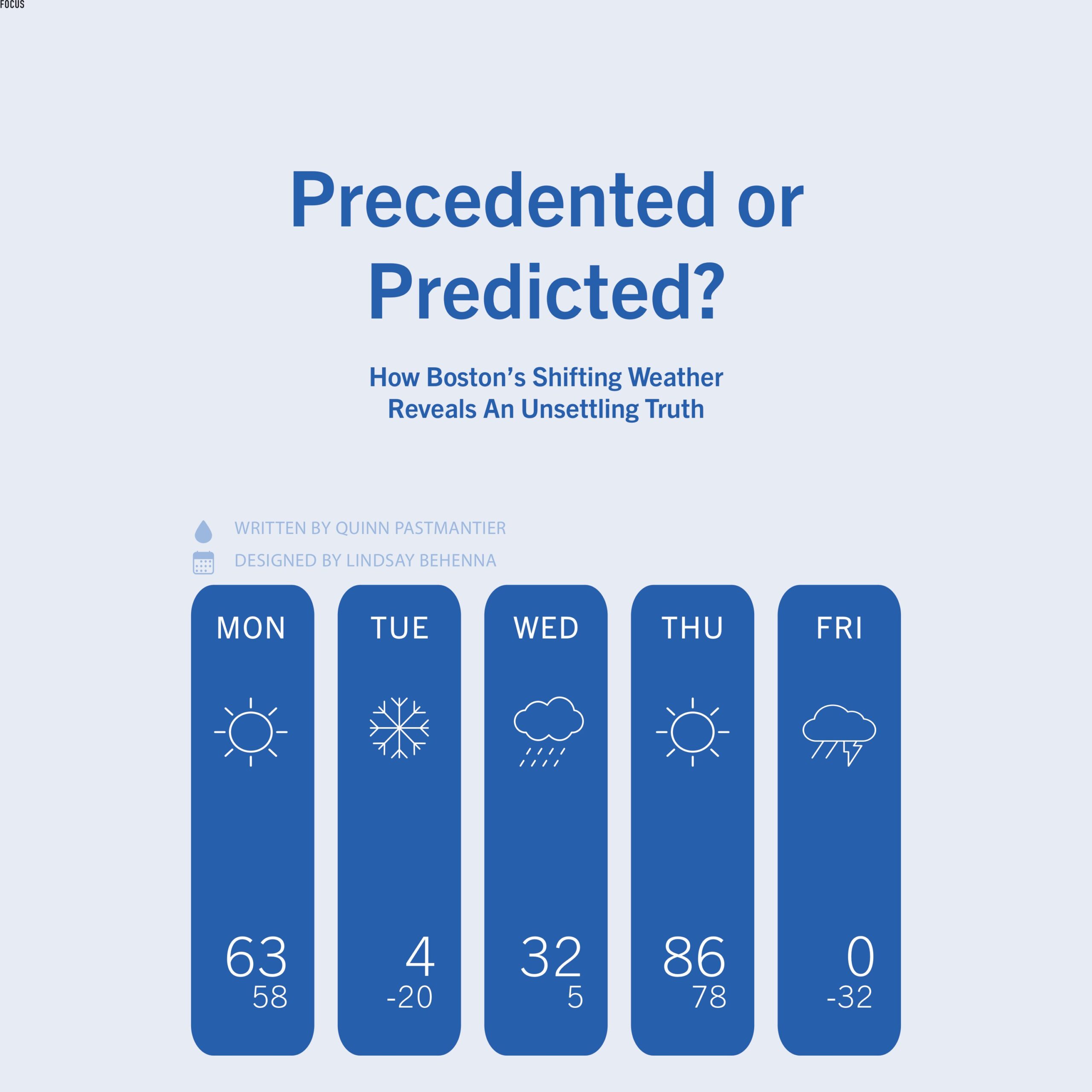
Boston’s weather this semester has been nothing short of a meteorological rollercoaster.
Whether it was average temperatures like 48 degrees Fahrenheit and 12 degrees Fahrenheit appearing in the same week, or hot rainstorms followed by windchill warnings, no one could figure out if they needed to bring an umbrella, a tank top, or a heavy coat when going outside. These sporadic changes in weather have been mostly reserved for amusing small talk — but their implications could reveal a much larger, rapidly-growing problem.
According to a November 2022 study by Climate Central (a neutral-policy organization that tracks climate trends), the Northeast’s winter season has warmed a total of 3.3 degrees Fahrenheit since 1970. However, recent weather trends in Boston indicate increased levels of snowfall. So, if temperatures aren’t getting any lower, what’s causing this unexpected rise?
The polar vortex is a swirling, low-pressure expanse of cold air present in polar regions, such as the Arctic. When disrupted, this phenomenon is responsible for random bouts of severe cold in the northern United States. While it’s not uncommon for the vortex to suddenly weaken every couple of years, rising temperatures within the Arctic have caused this disturbance to become more common. This, in combination with the warm waters of the Gulf Stream starting to linger along the East Coast, causes a rather unusual situation: a mild winter with severe storms.
While indecisive weather is mostly just a mild annoyance for college students, it has a greater impact on the Northeast as a whole. The outdoor recreation industry, including skiing, skating, and other winter sports, is a main economic and cultural trademark in this region of the United States. It also supports a large number of jobs — many of which are struggling to thrive. Rising temperatures cause the winter sports season to shorten, leading to ski companies spending more on synthetic snow than their employees. Similarly, rising river and ocean temperatures will have an impact on recreational ice fishing, with thinning ice causing the entire sport to become a little more dangerous. Local wildlife, as well, is starting to feel the effects of the increasingly unpredictable weather. Snowshoe hares, for example, have begun to shed their summer coats early. This would not be a problem, save for the fact that their winter coats are usually pure white so that they can blend in with the snow. With no camouflage, however, they are now overhunted by predators, who have less of a challenge spotting them. Another area being affected is the Northeast’s natural greenery. As rain replaces snow, important nutrients in the soil can be accidentally washed into rivers and pulled away from the forests and fields that need them most. This makes it much more difficult to grow plant life, especially in combination with sudden frosts causing tree roots to rot.
Warm winters in the Northeast always have a slightly eerie feeling to them. Boston, especially, is well-known for its cold weather, so to see the city without it brings somewhat of an awkward tinge to the entire season. During these bouts of heat, it’s not uncommon to overhear casual jokes whose punchlines are usually “climate change,” followed by slightly nervous laughter and several exchanged looks. When the anxiously-awaited snow finally does arrive, however, the jokes disappear, taking the uncomfortable feeling with them. This, though, is what makes unpredictable weather far more dangerous than if it had just been consistently warm.
Once a snowstorm arrives, it’s easy to assume that everything’s gone back to normal — If it’s still cold enough to snow, it means the climate isn’t changing that much, right? A deeper dive into the root causes of these sudden storms would reveal quite the opposite. It’s important to remember that the most dangerous problems are often the most ignored — if you have the resources, do your research on how you can help prevent further damage to the environment. If action isn’t taken soon to prevent the melting of the polar ice caps (and subsequently, the entire Arctic), weather like this might just become alarmingly familiar.